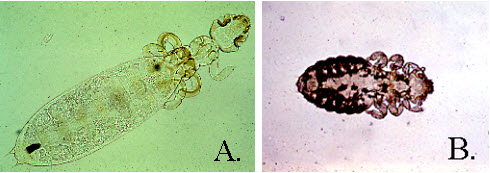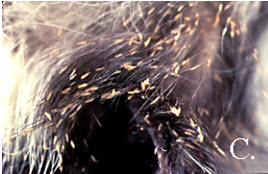Etiology:Gliracola porcelli (A.) and Gyropus ovalis (B.) are chewing lice that commonly parasitize guinea pigs

Incidence: Incidence of infection is rare in research colonies (G. porcelli more common than G. ovalis). Lice are generally host-specific.
Transmission: Transmission occurs by direct contact and mutual grooming.
Distribution: Lice are found over the dorsum, especially the rump and the perineum.
Clinical Signs: Clinical signs are not usually observed. Rough hair coats, alopecia and pruritis may be seen in heavy infestations.
Diagnosis: Antemortem
- Pluck hairs and examine subgrossly (dissecting microscope) or microscopically for lice or eggs.
- Run cellophane tape against the grain of the fur, place on a slide and examine microscopically for lice or their eggs. This method is not very reliable for detection.
Postmortem
- Place pelage (fur) samples collected from the rump and perineum in a Petri dish. As the pelage cools, lice will migrate towards the tips of the hair shafts and be visible with a dissecting microscope.
- Place pelage samples on black construction paper. As the pelt cools, the lice will crawl away and be visible as white specks on the black background (C).

Diagnostic Morphology: Gliracola porcelli: Long head, broader than the thorax; slender body; concealed antennae without tarsal claws.
Gyropus ovalis: Wide head (broader than the thorax), short antennae and one tarsal claw per leg.